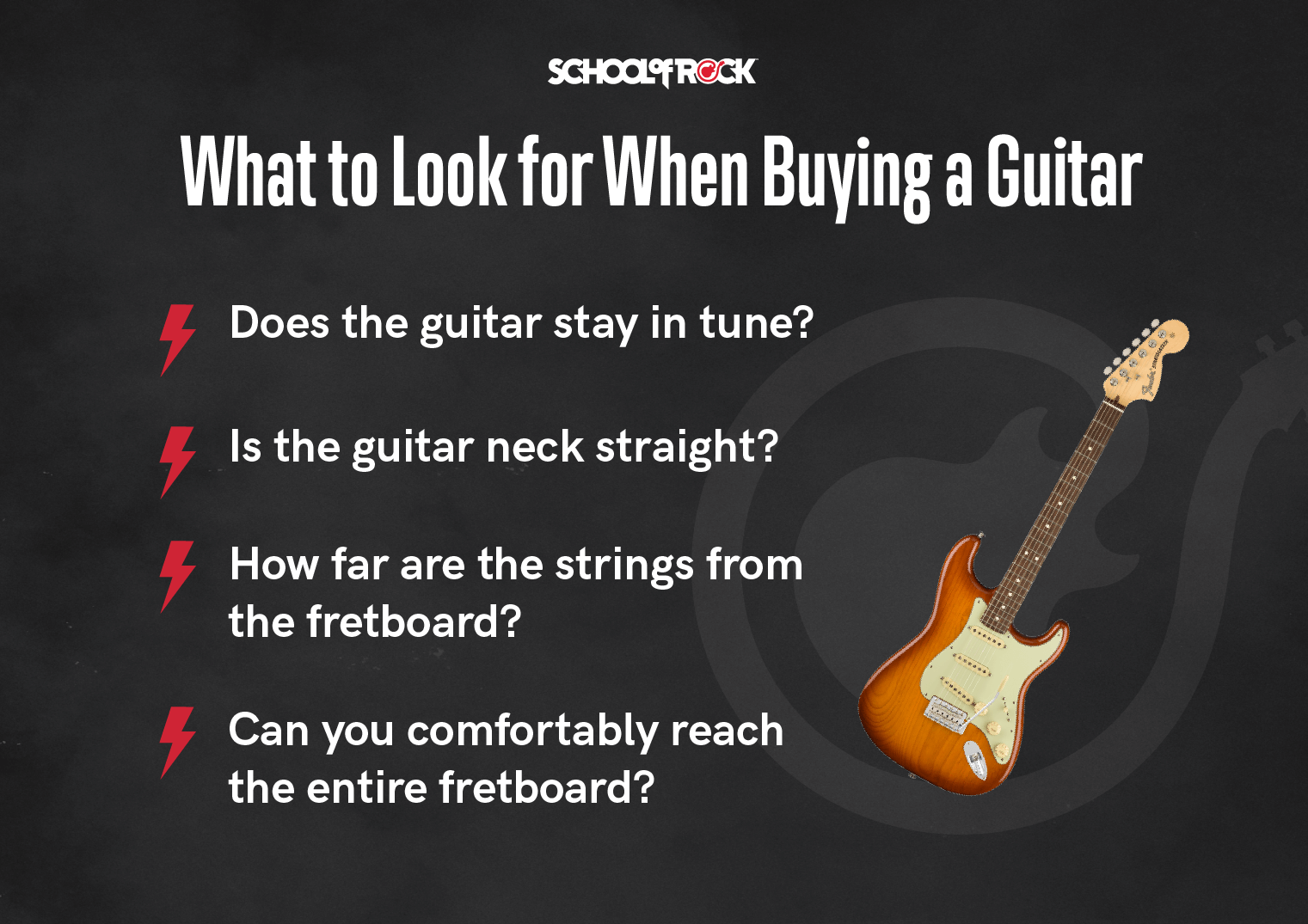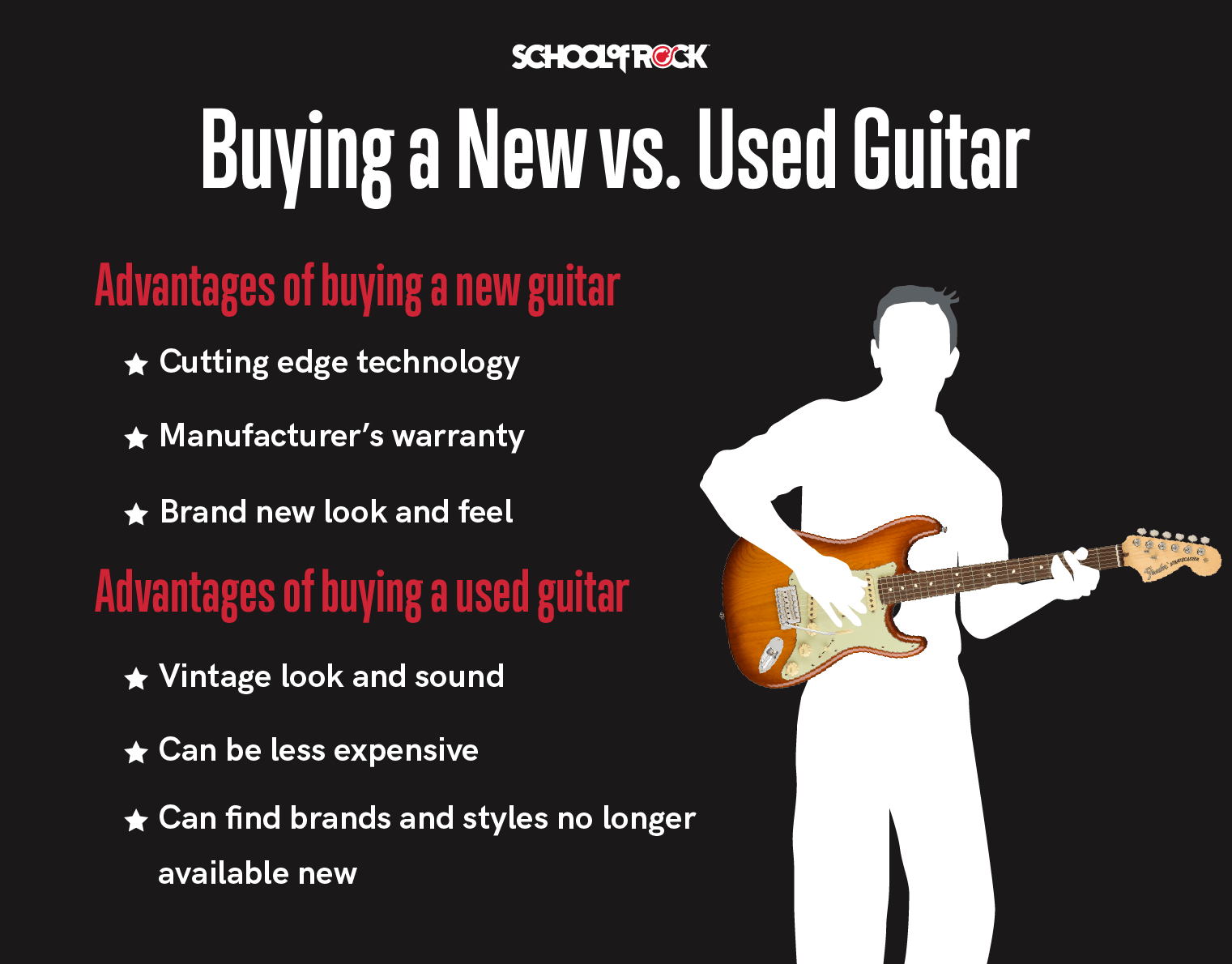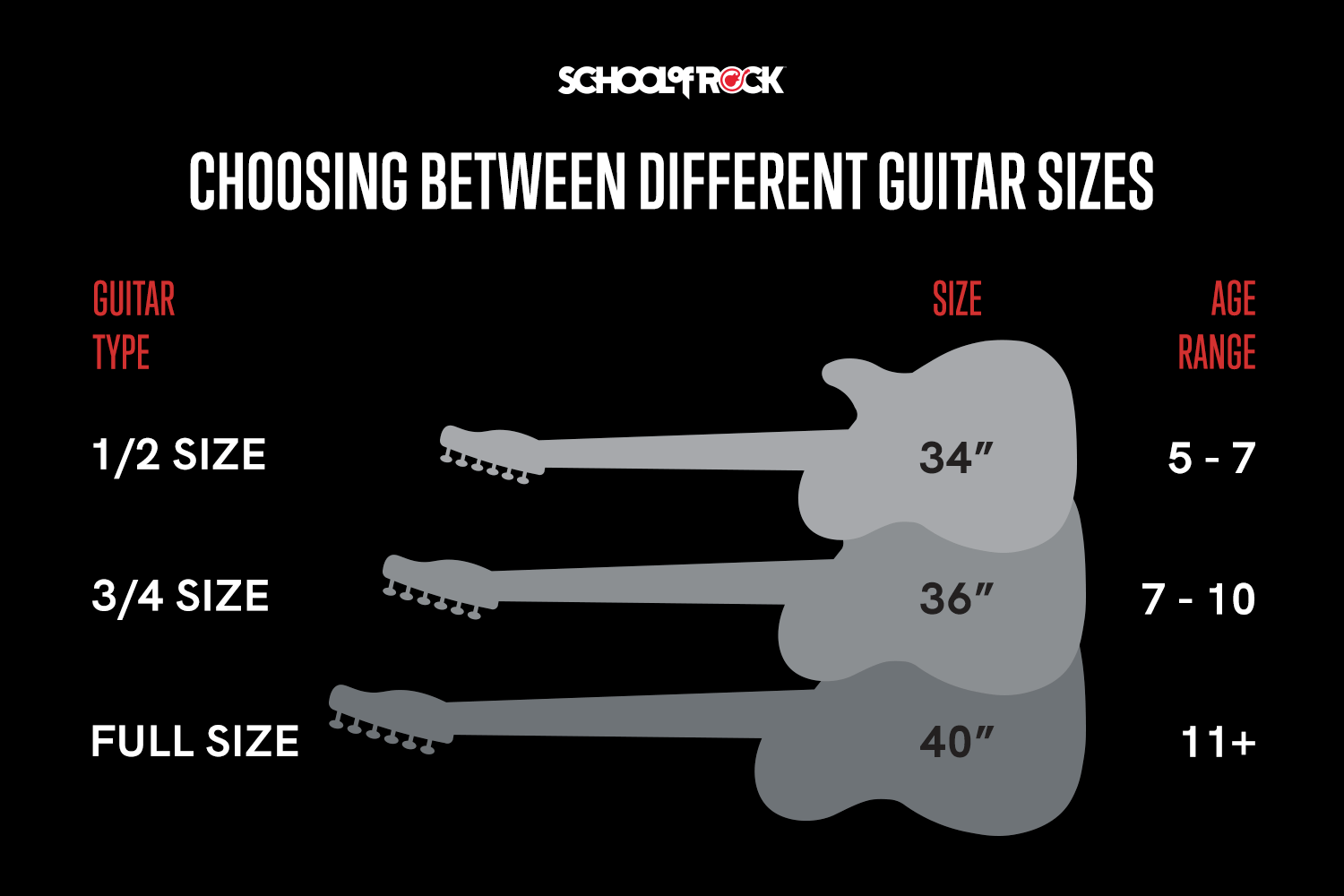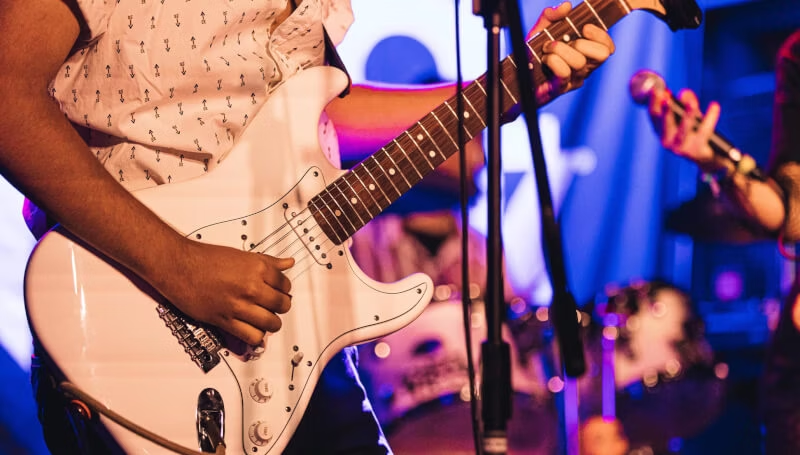Shopping for your first instrument should be the initial step in a lifelong journey of learning and inspiration. It can also be confusing because all musical instruments come in so many different makes and models.
If you’re buying your first guitar, you’ll face choices like what size guitar to buy, deciding between an acoustic or electric, or whether to invest in a new or used instrument. While there are many variables that might affect your decision, the most important thing is to find a guitar that sounds good, looks good, and feels good to play - to you.
There are countless styles of guitars available, and everyone has their own personalities and tastes. Above all, the instrument should inspire you, and make you want to practice more frequently. From deciding between types and styles, to deciding between which guitar sizes to buy, this guitar buying guide will help simplify the process of finding the best beginner guitar for you.
Click below to jump to a section in the guitar buying guide.
Choose the right guitar for a beginner
One of the questions we get most often at School of Rock is which guitar parents should buy for their child who wants to start learning to play. Here are a couple of pointers to help you find out how to buy a guitar for a beginning musician. Once you've put a sweet guitar into your kid's hands, come to School of Rock for a tour and free trial lesson, and we'll help them love playing it.
There are a few general categories of guitar that are very popular. These styles have very different sound and playability characteristics. Deciding the style of which guitar to buy in advance will help narrow down your choices considerably.
One of the most important concepts behind the success of School of Rock is that if students are inspired by their instrument they'll get better that much faster. Your kid’s favorite bands and styles of music will be a good indicator of the best beginner guitar to buy for capturing their attention.
Buying an electric guitar for a beginner
Out of all the types of guitars, electric guitars are by far the most popular style used in modern music. Electrics produce only the faintest of sound on their own, but once connected to an amplifier they open up a world of potential for a variety of sounds. These guitars are primarily used in rock, metal, pop, blues, jazz, country, and R&B.
Advantages of an electric guitar
- Easier to play than acoustic or classical
- Available in many sizes, making them perfect for young players
- Versatile and capable of of producing a variety of tones
- Used frequently in most popular styles of music
- With the amplifier, can be set to be as loud or soft as desired
Disadvantages of an electric guitar
• Require some additional accessories, such as an amplifier and connector cable, in order to achieve a full sound
Buying an acoustic guitar for a beginner
Acoustic guitars are built to produce a rich sound with no electric amplification. Out of all types of guitars, they are most commonly used in genres like folk, singer-songwriter, country, and bluegrass, but are occasionally used in rock, blues, and R&B as well.
A lot of parents ask about the difference between starting on acoustic guitar versus electric guitar. At the core, they are the same instrument, and concepts learned on one are immediately transferable to the other. However, an electric guitar may be the best beginner guitar for learning, as it is usually a little easier to play since the neck is narrower and the strings are easier to press down.
Advantages of an acoustic guitar
- Does not require additional amplification
- Can be amplified with a removable pickup
- Bright sound that is great for playing chords
- Get a better first instrument using money saved by not needing an amp
Disadvantages of an acoustic guitar
- Many models require additional equipment installed to plug into an amp or sound system, making it tougher to be heard while playing with a band
- Limited range of sounds and tones
- Requires thicker strings, making it harder to play for a beginner
- Some short scale and beginner models are poorly made
What is an acoustic-electric guitar?
If you feel like you need a guitar that combines the advantages of electric and acoustic, you may want to consider an acoustic-electric guitar. Since performers often use acoustic guitars in large venues, acoustic guitar makers produce models that have built-in microphones, or pickups. The advantage is that these guitars function and sound exactly like an acoustic guitar, but when needed, they can be plugged in and amplified through an amp or house sound system.
Most acoustic-electric guitars have some level of tone control in the form of an on-board equalizer. The drawback is that because these guitars have electronic hardware not found in acoustic guitars, you can expect to pay more. But the cost may be comparable to an electric guitar, so depending on the style of music you want to play, an acoustic-electric may be an option.
What to look for when buying a guitar
There's no way to poke and prod anything you buy online before it's at your door, so if you're shopping in person, here are a couple of things to watch out for. Important note about new instruments: One of the ways that guitar manufacturers save cost is by putting minimal labor into the final setup of the instrument.
Often the parts are quality and the assembly is fine, but the fine-tuning that makes an instrument play well and sound its best is left to the consumer.

1. Does the guitar stay in tune?
Have someone at the store get the guitar to standard tuning and play a few chords. There are two reasons to do this.
First, if the playing sounds terrible, odds are it's not the sales person (who is likely a decent guitar player), it's a difficult instrument to play. The second reason to have the instrument tuned up is to check the action.
2. Is the guitar neck straight?
Check the neck of the guitar for any curves or bends. Ideally, your guitar should have a straight neck, and prevent the strings from hitting the frets as you play.
If the guitar has a bow or back bow, it can make playing the guitar more difficult, especially for beginners. If you're unsure of how to check your guitar's neck relief, ask a professional. They should be able to check and identify any potential problems with your guitar neck, and make corrections as needed.
3. How far are the strings from the fretboard?
The action of a guitar or bass is how the strings relate to the fretboard. Check The action is something that can be adjusted pretty easily, but if the strings are super far from the neck at the point where the neck and body of the guitar meet or the neck is noticeably curved, it might be an instrument to pass up.
That doesn't necessarily mean that brand or model are flawed, just that the individual instrument may already have some problems.
4. Can you comfortably reach the entire fretboard?
If the guitar sounds all right and the action doesn't look way out of whack, see if you can comfortably reach the entire fretboard. Run your finger along each side of the neck to see whether you can feel any of the ends of the metal frets sticking out.
If you feel some that aren't level with the wood, it doesn't mean the instrument is garbage or that brand or model are no good, but you can probably find another guitar or bass that doesn't already have that problem. Frets that aren't level with the wood can be fixed, but there's no reason to deal with that if you're buying a new instrument.
5. Are the guitar electronics in good condition?
If you're looking at an electric guitar, get it plugged into an amp and toggle all the switches and turn all the knobs a few times. If you hear any crackling sounds, it means some of the internal electronics may be a little dirty.
Again, that's a fixable problem, but not something you want to hear a few minutes after your kid plugs it in for the first time. Another of the same brand and model will probably be fine, if you're looking at what you think is a good style and price point.
Buying a new vs. used guitar
Buying a used guitar can be a great way for a young player to move up to a pro-level instrument. High-end guitars will age well if cared for, and there are a lot of professional musicians using fifty to sixty year-old classic models from manufacturers like Fender and Gibson.

But manufacturers tend to make guitars available at an entry-level price by using materials that don’t age as well - metal pieces that are thinner (weaker) and wood that is softer. So when buying a starter guitar, new may be the safest route. But if you’re buying used, pay attention to all of the potential issues listed above, but with a higher level of scrutiny. Here are some additional points to consider if you’re still on the fence:
Advantages of buying a new guitar
If your student is highly motivated and big enough to play a full size guitar, you may want to invest in a new instrument from a trusted manufacturer. By buying new you will get:
- Cutting edge technology
- Manufacturer’s Warranty
- Brand new look and feel
Advantages of buying a used guitar
If you feel like your student is still exploring their options, or if you’re buying a ½ or ¾ sized guitar that will only be used for 3-4 years, a used instrument may bring the most value. The advantages of a used guitar can include:
- Vintage look and sound
- Less expensive
- Finding brands and styles no longer available new
Select the right guitar size
Good starter guitars come in many shapes and sizes, and finding an instrument that feels good and “fits” is super important for any aspiring student – especially younger students who are not yet fully grown. Incorrect guitar sizes can affect your ability to play, and young students can struggle with full-size guitars due to the width of the guitar neck, heavier weight, the wider spacing of the frets, and may be unable to play all the notes.
While it may be tempting to buy a full size model that a student can “grow into,” the reality is that a student will likely become frustrated trying to play an instrument that is too large for their body and hands. Several guitar manufacturers make small scale guitars, and these can be great options for young students who are just starting out.
Guitar sizing chart
When choosing between guitar sizes, you may need to consider the age of who you’re buying the guitar for. Generally, our experts recommend a half-size guitar for ages 5 - 7, a three-quarter size guitar for ages 7-10, and full size guitar for ages 11 and up.
These recommendations are based off the average heights for these age ranges, so you may need another size depending upon the height of your child.

Total length vs. scale length of a guitar
Manufacturers make guitars in ¾ and ½ sizes so they’re easier for young students to play. But in determining the best size guitar for your student, you’ll need to consider the overall length of the guitar as well as the scale length. Two short scale guitars, both considered ¾ sized guitars, can have a different overall length and body shape/thickness, so you should always have your student hold the guitar to make sure they can comfortably reach the entire neck.
These scaled down models are easier to play for young students because the neck is shorter, making them short scale guitars. Scale length is the measurement of the string length between the nut and saddle. Basically, this is the part of the string that vibrates when played.
A scale length of 25 to 25.5 inches is considered long scale, which is standard on a full sized guitar. Anything between 24.5 and 21 inches is short scale. Because all scale lengths use the same strings, a shorter scale guitar will have less tension on the strings when tuned. This makes the strings easier to fret for a younger student.
Best guitar brands for learning
There are lots of great options for a first guitar that are inexpensive and totally decent. If cost is your main consideration, you can still give your budding musician a good starter guitar they'll feel good about bringing to band practice. If your kid is ready for something a little more serious, there are a lot of possibilities for which guitar to buy.
Buying a Fender Squier vs. Gibson Epiphone guitar to learn on
If you’re looking for a guitar for learning, the two biggest names in guitar manufacturing have affordable sub-brands that are an easy go-to choice – Fender makes Squier instruments and Gibson makes Epiphone.
Are these brands good for beginners?
Both brands have a range of options for first-time players, such as starter packs that include a guitar, amp, cable, and all the trimmings that will get your kid plugged in and ready to shred the classics for a couple hundred bucks and change. Both brands also have small scale options for younger students: Fender Squier, Fender Squier Mini, and Epiphone Junior.
There are other guitar makers competing at the same price point, and many are making instruments of comparable quality. Read up on online reviews and feel free to give us a call if you'd like input.
Other good guitar brands for beginners
As a buyer, you may not want to purchase an expensive instrument for a beginner who is just learning the guitar, but if you take a step up the cost scale there are enough options to make your head spin. There are nicer Fenders and Gibsons, along with other more upscale brands such as PRS (Paul Reed Smith).
Some lesser known brands, such as Gretsch and Schecter, also offer guitars with unique looks and sounds. All of these brands have good reputations for making quality instruments, but the most important thing is whether the guitar inspires the student and makes them want to play.
Where to buy a guitar for beginners
While ordering a guitar online may seem like an easy and less expensive option, it’s important that any aspiring guitar player see, hold, feel, and hear the instrument in person before purchasing it. You should always go to a guitar shop when buying a first guitar for yourself or your child.
We recommend that you go into a store with a small list of some professional guitar players or guitar songs you like. Even if you have no musical experience, the salesperson most likely does. They can get a sense of what kind of sound you like, and explain or demonstrate the differences in sound of the varieties of guitar to help you decide on an instrument.
What are some guitar accessories you will need?
When it comes to deciding how to buy a guitar, it’s important to look at guitar accessories to get you playing in no time.
Basic guitar accessories include:
- Guitar amps: An amplifier is a necessary accessory for an electric guitar. In most cases, a small “practice amp” will suffice for newer students. Students interested in rock, pop, and blues may desire a “two-channel” amp - that is, one with the capability of both clean tone and distorted tone.
- Instrument cable: The instrument cable connects the electric guitar to the amp. You want to make sure the cable is long enough to reach from the amp to the student’s chair or stool. A 10’ cable or larger should suffice.
- Headphones: Many amps have headphone jacks, which are useful for keeping practice volume inaudible to family members, neighbors, pets, etc.
- Guitar tuner: A tuner is a necessary accessory for any type of guitar. Acoustic guitars will require a tuner with a built-in mic, while electric guitars require a tuner that can be plugged into. Alternatively, headstock tuners work by vibration and are fine for any type of guitar. Most tuner models are relatively inexpensive.
- Guitar picks: Guitar picks are plastic plectrums used to strike the strings. They come in a variety of thicknesses - “medium” pics are good for beginners, until the students develop a preference.
- Guitar straps: All electric guitars and most acoustic guitars are set up for use with a strap. Most straps are adjustable for size, but try it out before you buy to make sure it’s a comfortable fit.
- Extra strings for your guitar: Guitar strings occasionally break through regular use, so an extra set of strings is a good investment. Make sure to buy strings that are compatible with either an electric or acoustic guitar.
- Guitar case: A guitar case is a must for protecting the instrument during travel. Soft cases (“gig bags”) are inexpensive and fine for car rides and general use. Hard cases offer greater protection for more upscale instruments or when taking the guitar on an airplane.
Ready to play your new guitar?
The last thing you want, once you've picked out the right guitar for your kid, is to have it sit untouched for the rest of her/his childhood. At School of Rock, we focus on teaching students to enjoy playing their instrument first and build the broader concepts of music on top of that foundation, using performance as the motivation and the payoff.
When students know that they're going to walk out on stage in a real rock venue and play a legit concert, the practicing tends to take care of itself. We would love for your child to have all of the pieces in place the second they get their instrument – guitar lessons, bass lessons, a beginner or intermediate/advanced winter day camp, a concert to start rehearsing for.
At School of Rock, we take total beginners and, within a few short months, have them performing on stage, going on tour, building confidence, and making lifelong memories and friendships with kids that love the same things they do.







